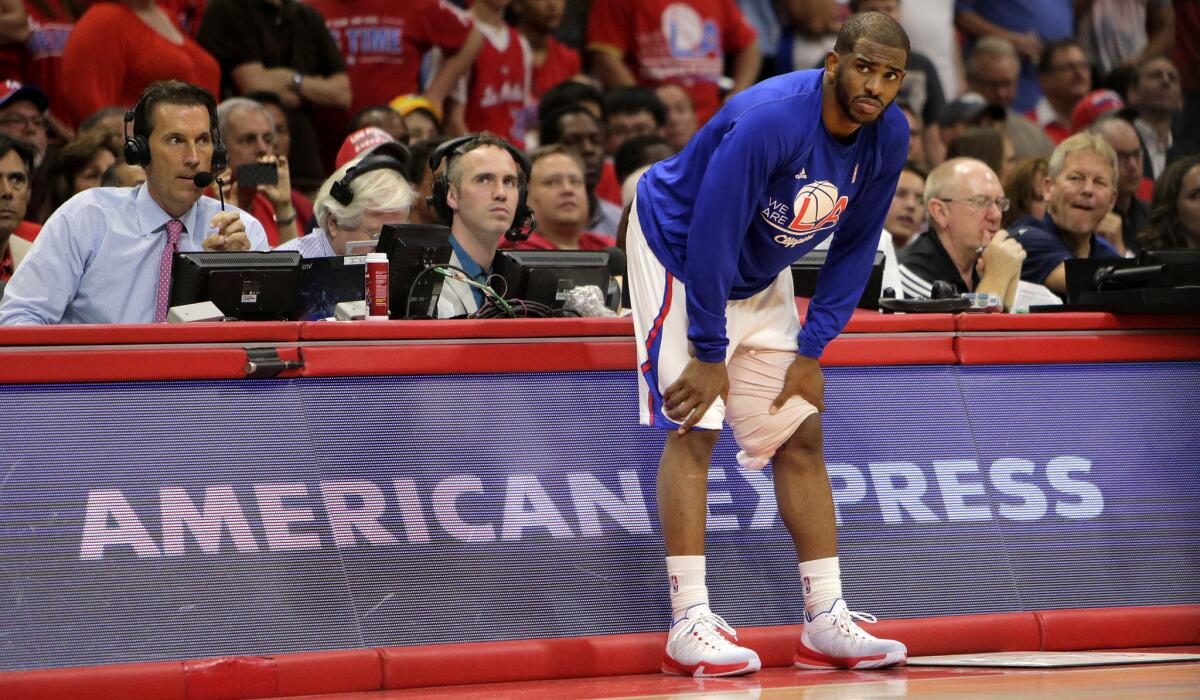Column: Beware the hamstring injury, tormentor of Chris Paul and many others

Clippers point guard Chris Paul prepares to go back into Game 7 after injuring his left hamstring. The injury, though, has prevented him from playing in the second-round series against Houston.
- Share via
An athlete would almost be better off breaking a bone than yanking a hamstring, the trifecta of tissues in the back of the thigh that has felled so many fine performers.
Chris Paul seems made of yacht metal, but a bad hamstring had even him on the rocks over the weekend. Somehow, the Clippers’ superstar managed to beat the Spurs on one leg Saturday night.
Yet the very mildest injuries take from one to two weeks to recover from, making Paul’s injured left “hammy” a major question mark in the Clippers’ playoff prospects. Stubborn beyond belief, hamstrings can seem healed; then they’re not.
Ever since a cave man reached too quickly for a spear, hamstring strains have been the wolfsbane of warriors — weekend and otherwise.
How devastating can a damaged hamstring be? In ancient times, knights would disable adversaries with a sword across the back of the thigh. Soldiers reportedly severed the hamstrings of prisoners to keep them from escaping.
“Hamstrung,” meaning disabled, is believed derived from such cruelties.
New York Yankees great Mickey Mantle once collapsed in a heap after ripping a hamstring while trying to beat a throw to first.
These days, hamstrings account for 29% of all athletic injuries, a study by Columbia University’s department of orthopedic surgery found.
Michael Vick, Lionel Messi, LeBron James have all struggled with strains and tears. Fickle and merciless, hamstring problems recur with agonizing frequency — the re-injury risk is 12% to 31%, the Columbia study found.
Even a moderate strain can take months to heal properly. The worst — a tear off the bone — require a surgeon’s needle and thread.
Break an arm and cast it, the bone often recovers as strong as ever and on you go. Rip a hamstring, and those little muscle fibers can fray like a crummy kite.
Hamstring injuries tend to strike quick-twitch positions, such as sprinters, point guards and NFL speedsters.
Last week, Angels slugger Albert Pujols strained a hamstring on takeoff from the batter’s box. Most injuries occur during jump starts or leaping — as with Paul or Mantle — or with rapid braking.
“The worst hamstring injury I ever saw involved Andy Pafko,” Vin Scully told me earlier this week. “His hamstring pull went from his hip to behind his knee, and it looked like he had been beaten by chains and a crowbar.”
Hamstring comes from the old English “hamm,” meaning thigh. String refers to the tendons above the back of the knee. Go ahead, reach behind your leg and squeeze. Hello, hamstrings — the same muscles that burn a little after a hike.
But even in the mildest cases, they can be a ribbon of hurt.
The reason injuries happen so frequently is because tendons cross both the hip and the knee, making them prone to over-lengthening, said Dr. Seth Gamradt, an orthopedic specialist at USC’s Keck Medical Center.
A rubber band can stretch only so far, and so it is with hamstrings. Typically, such strains are mid-thigh, Gamradt said, and an MRI is used to gauge severity. When bleeding occurs, the back of the leg blossoms into a big, Bible-colored bruise.
According to experts, it’s not merely a matter of flexibility, but also strength. The front thigh muscle might be significantly stronger than the hamstring, too demanding for its counterweight in the back.
An athlete’s right leg might be stronger than the left, prompting overwork on one side.
A study of soccer players showed that those with stronger hamstrings were less likely to suffer injuries, Gamradt said. That may be one of the reasons the NFL and NBA see more hamstring injuries early in the season, when muscles aren’t at their peak power.
For example, Giants wideout Odell Beckham Jr. missed the first four games of his sensational 2014 season with hamstring issues.
Inadequate stretching during warmups is also a frequent factor in hamstring injuries, as are fatigue and dehydration.
Once the injury happens, “It’s one of those things doctors can’t do a lot for,” Gamradt said.
Ice. Elevation. Advil.
Many times, medical personnel will inject the area with platelet-rich plasma. The gin in the martini, the platelets promote muscle regeneration and healing.
Trainers usually insist that an injured athlete continue a range of motion to reduce the chances of scar tissue and fiber weaknesses further down the line.
“There’s no foolproof way to prevent them,” Gamradt said.
On such unknowns — and ancient frustrations — a Clippers season hangs.
Twitter: @erskinetimes
More to Read
Get our high school sports newsletter
Prep Rally is devoted to the SoCal high school sports experience, bringing you scores, stories and a behind-the-scenes look at what makes prep sports so popular.
You may occasionally receive promotional content from the Los Angeles Times.







